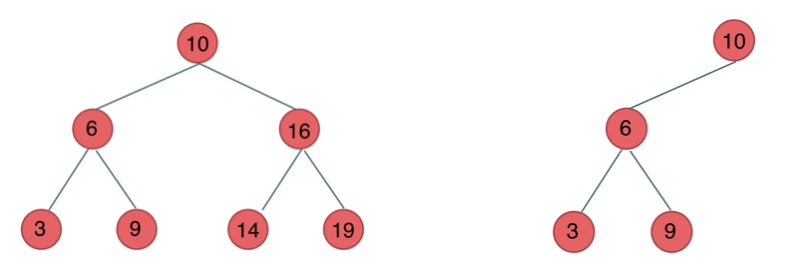二叉树概念
满二叉树
满二叉树:如果一棵二叉树只有子节点数量为0或2的结点,并且子节点数量为0的结点在同一层上,则这棵二叉树为满二叉树。

这棵二叉树为满二叉树,也可以说深度为k,有2^k-1个节点的二叉树。
完全二叉树
在完全二叉树中,除了最底层节点可能没填满外,其余每层节点数都达到最大值,并且最下面一层的节点都集中在该层最左边的若干位置。若最底层为第 h 层(h从1开始),则该层包含 1~ 2^(h-1) 个节点。

二叉搜索树
二叉搜索树是有数值的了,二叉搜索树是一个有序树。
- 若它的左子树不空,则左子树上所有结点的值均小于它的根结点的值;
- 若它的右子树不空,则右子树上所有结点的值均大于它的根结点的值;
- 它的左、右子树也分别为二叉排序树
下面这两棵树都是搜索树

平衡二叉搜索树
平衡二叉搜索树:又被称为AVL(Adelson-Velsky and Landis)树,且具有以下性质:它是一棵空树或它的左右两个子树的高度差的绝对值不超过1,并且左右两个子树都是一棵平衡二叉树。

二叉树的存储方式
指针,或数组
二叉树的遍历方式
- 深度优先遍历:先往深走,遇到叶子节点再往回走。前序遍历、中序遍历、后序遍历的区别在于根节点遍历的顺序
- 前序遍历:中左右
- 中序遍历:左中右
- 后序遍历:左右中
- 广度优先遍历:一层一层的去遍历。
C语言中的二叉树节点结构体类型定义
struct TreeNode {
int val;
struct TreeNode *left;
struct TreeNode *right;
};二叉树的递归遍历
递归算法三要素:
- 确定递归函数的参数和返回值
- 确定终止条件
- 确定每一层递归的逻辑
前序遍历
以下假设二叉树中最多只有100个节点
void subPreorder(struct TreeNode* root, int* ret, int* returnSize)
{
if(root != NULL)
{
ret[(*returnSize)++] = root->val;
subPreorder(root->left, ret, returnSize);
subPreorder(root->right, ret, returnSize);
}
}
int* preorderTraversal(struct TreeNode* root, int* returnSize){
int* ret = (int*)malloc(sizeof(int) * 100);
*returnSize = 0;
subPreorder(root, ret, returnSize);
return ret;
}中序遍历
void subInorder(struct TreeNode* root, int* ret, int* returnSize)
{
if(root != NULL)
{
subInorder(root->left, ret, returnSize);
ret[(*returnSize)++] = root->val;
subInorder(root->right, ret, returnSize);
}
}
int* inorderTraversal(struct TreeNode* root, int* returnSize){
int* ret = (int*)malloc(sizeof(int) * 100);
*returnSize = 0;
subInorder(root, ret, returnSize);
return ret;
}后续遍历
void subPostorder(struct TreeNode* root, int* ret, int* returnSize)
{
if(root != NULL)
{
subPostorder(root->left, ret, returnSize);
subPostorder(root->right, ret, returnSize);
ret[(*returnSize)++] = root->val;
}
}
int* postorderTraversal(struct TreeNode* root, int* returnSize){
int* ret = (int*)malloc(sizeof(int) * 100);
*returnSize = 0;
subPostorder(root, ret, returnSize);
return ret;
}非递归写法
前序遍历
遍历节点时,即时处理将节点的值加入结果,接着先将右节点入栈再将左节点入栈,这样当取栈顶元素时是先处理左节点
int* preorderTraversal(struct TreeNode* root, int* returnSize){
int* ret = (int*)malloc(sizeof(int) * 100);
struct TreeNode* nodes[100];
struct TreeNode* temp;
int nodesSize = 0;
if(root != NULL)
{
nodes[nodesSize++] = root;
}
*returnSize = 0;
while(nodesSize != 0)
{
temp = nodes[--nodesSize];
ret[(*returnSize)++] = temp->val;
if(temp->right != NULL)
{
nodes[nodesSize++] = temp->right;
}
if(temp->left != NULL)
{
nodes[nodesSize++] = temp->left;
}
}
return ret;
}中序遍历
有左节点就一直先处理左节点,并将遍历过的节点不处理直接入栈
当当前节点为空时,代表一路下来的左节点都已入栈,此处取出栈顶元素,将节点的值加入结果,将右节点加入栈,重复上一步操作
int* inorderTraversal(struct TreeNode* root, int* returnSize){
int* ret = (int*)malloc(sizeof(int)*100);
struct TreeNode* nodes[100];
struct TreeNode* curr = root;
int nodesSize = 0;
*returnSize = 0;
while((curr != NULL) || (nodesSize != 0))
{
if(curr != NULL)
{
nodes[nodesSize++] = curr;
curr = curr->left;
}
else
{
curr = nodes[--nodesSize];
ret[(*returnSize)++] = curr->val;
curr = curr->right;
}
}
return ret;
}后序遍历
有点绕,逻辑见代码注释
int* postorderTraversal(struct TreeNode* root, int* returnSize){
int* ret = (int*)malloc(sizeof(int)*100);
struct TreeNode* nodes[100];
int nodesSize = 0;
struct TreeNode* curr = root;
struct TreeNode* preNode;
*returnSize = 0;
while((curr != NULL) || (nodesSize != 0))
{
/* 新拿到一个节点,先一直向左节点遍历, 将经过的节点入栈 */
while(curr != NULL)
{
nodes[nodesSize++] = curr;
curr = curr->left;;
}
/* 程序运行到这一步时curr为空,取出栈顶指针 */
curr = nodes[--nodesSize];
/* 程序运行到这一步时,curr节点的左节点一定为NULL或已经处理过, 处理curr及其右节点 */
if(curr != NULL)
{
if(curr->right == NULL) /* 若当前右节点为空,直接将值接入结果, 记录本节点处理过 */
{
ret[(*returnSize)++] = curr->val;
preNode = curr;
curr = NULL;
}
else if(curr->right == preNode) /* 若右节点也已经处理过,直接将值接入结果, 记录本节点处理过 */
{
ret[(*returnSize)++] = curr->val;
preNode = curr;
curr = NULL;
}
else /* 若右节点不为空,且未处理过,将当前节点放回栈里,进入右节点进行处理 */
{
nodes[nodesSize++] = curr;
curr = curr->right;
}
}
}
return ret;
}




















 766
766











 被折叠的 条评论
为什么被折叠?
被折叠的 条评论
为什么被折叠?








